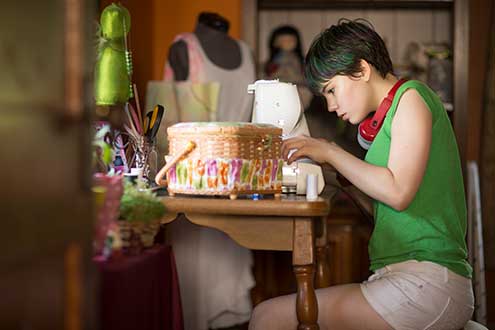Keeping Lucky on the Move
13-year-old girl finds answers to debilitating pain and weakness, and returns to her active lifestyle
Eighth-grader Lucky Eschauzier has been busy lately.
She started a rock band with her brother, helped Thacher Montessori School in Braintree, Massachusetts to win a basketball title, expanded her clothing line, and took her horseback riding skills to the next level. That’s just to name a few of her accomplishments.

Keeping Lucky on the Move
A year after surgery, 13-year-old Lucky Eschauzier has returned to the activities she loves most, including playing in a rock band with her brother, Leo.
Watch the video.
It’s hard to imagine 13-year-old Lucky being held back, but that was the case several years ago. Lucky has lived with Ehlers-Danlos syndrome, a collection of connective tissue disorders that severely decreases her mobility and inflicts pain, including migraines.
Her parents, Deirdre and Chase Eschauzier, became convinced that her symptoms went beyond those typical of Ehlers-Danlos. Their frustration grew as numerous tests and physician visits failed to pinpoint the problem.
Then the family met Petra Klinge, MD, a neurosurgeon at Hasbro Children’s Hospital.
“Dr. Klinge was the first doctor to say, ‘I think I can help your daughter,’” Mrs. Eschauzier recalls.
Looking beyond the MRI
The Eschauziers knew parents of kids with Ehlers-Danlos syndrome who also had tethered cord syndrome, a neurological disorder in which a piece of the embryonic spinal cord – the so-called filum terminale – pulls on and damages the spinal cord. The couple wondered if Lucky had the condition. However, physicians had told them that there was no evidence of the tethered cord, at least not that they could see on MRI scans.
That’s when the family made the short trip south to Hasbro Children’s Hospital. The first time Dr. Klinge met Lucky she was in a wheelchair. Because of her symptoms, Lucky had begun using the wheelchair when there was a need to cover longer distances.
“Lucky’s symptoms were ones that occur very early on with tethered cord syndrome, and they were very concerning,” explains Dr. Klinge. “When I heard that Lucky was experiencing these I knew there was something wrong with her tethered cord, and if left untreated, can be very devastating.”

The neurosurgeon does not rely solely on MRIs to diagnose the condition. Dr. Klinge has pioneered a three-pronged identification process for “occult (hidden) tethered cord,” looking at a combination of pain along with neurological, urological and orthopedic symptoms.
“Tethered cord is a structural and physiological problem of the spinal cord and related anatomical elements that can escape MRI imaging, so you have to be very diligent in looking at the whole person and trusting the person with his or her symptoms,” explains Dr. Klinge. After evaluating Lucky, she recommended surgery.
Lucky was struggling physically to keep up with her peers. “My chronic pain and fatigue caused constant stress. I was really fragile,” says Lucky.
‘Confident in myself and in life’
More than a year after Lucky’s surgery, Dr. Klinge says that Lucky, so far, is “a poster child” for tethered cord treatment. Lucky’s migraines have virtually disappeared. She’s able to keep up with her peers and maintain a typically busy teen schedule filled with schoolwork, playing basketball, singing and playing guitar in a band with her twin brother, Leo, and working on her clothing line. Dr. Klinge performed delicate micro-neurosurgery on Lucky, identifying the abnormal condition of the spine. She removed a small piece of the embryonic spinal cord that was tugging on Lucky’s spinal cord.

Health Check
Watch WPRI 12's Health Check segment about Lucky and the care she received at Hasbro Children's Hospital.
Dr. Klinge “sees what other doctors don’t see … that’s really cool. Now, I just feel really good. I feel like I am more confident in myself and in life,” says Lucky Eschauzier.
“The notion of Lucky even being on a basketball team – that would never have crossed my mind before she had this surgery,” says Mrs. Eschauzier. “But there she was – out there playing in the championship game and having the ability to run around. That was something I never could have even pictured beforehand.”
She adds that she and her husband do whatever they can to make other families aware of Ehlers-Danlos syndrome and tethered cord, and especially the diagnostic approach of Dr. Klinge.
Of the more than 150 occult tethered cord cases Dr. Klinge has overseen at Hasbro Children’s Hospital and Rhode Island Hospital, approximately 85 percent resulted in significant symptom improvement. The physician and researcher is now leading a clinical study to investigate the benefits of tethered cord surgery based on clinical symptoms, when there is no definitive MRI evidence. The study is also looking at why tethered cord cannot be seen on an MRI.
Lucky says the surgery has changed her life.
Dr. Klinge “sees what other doctors don’t see … that’s really cool,” Lucky explains. “Now, I just feel really good. I feel like I am more confident in myself and in life.”
